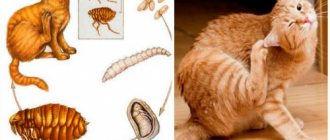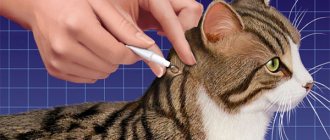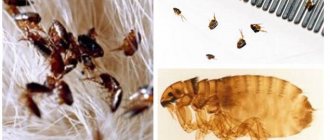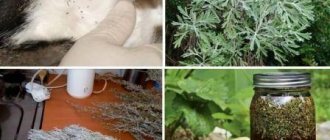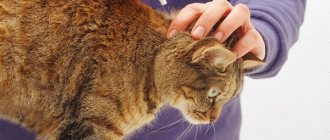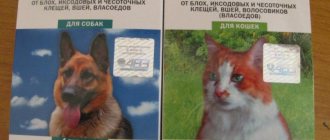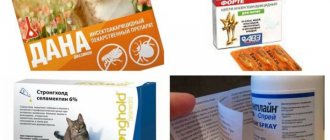What is better for fleas: drops or a collar?
Let’s immediately decide what is better for fleas: drops or a collar. Misconceptions in this matter drive many owners to despair. The fact is that the collar itself is an additional preventive measure. Putting a collar on a flea-infested kitten will not get rid of parasites!
The collar is used as a measure of additional protection, not even against fleas, but against ticks. After treatment with drops, the collar serves as a means of repelling new parasites. In addition, wearing a flea collar before the recommended age can lead to stunted growth and development.
How do flea drops work?
Many owners are interested in how flea drops work. The mechanism of action of the drug depends on the active ingredients. Common flea drops eliminate parasites in several ways:
- Disturbance of nervous activity - the flea drinks blood, after which paralysis and death occurs.
- Contact action - the poison penetrates the body of the parasite through direct contact.
- Repellent effect - some flea drops do not kill, but only repel parasites with their smell.
Important! The duration of action depends on the type of active ingredients and their dosage. Most often, drops protect a cat from fleas for 8 weeks, and from ticks for 4 weeks.
How often should I treat my kitten for fleas?
How often do you treat a kitten for fleas as a preventive measure? According to generally accepted rules, preventive treatment against parasites is carried out quarterly. The period is considered optimal to interrupt the reproduction cycle of most parasites.
If a cat is infested with fleas, treatment is carried out outside the schedule. If infection is repeated, it is recommended to change the drops, since their protective effect should protect the kitten from 4 to 8 weeks (depending on the drug). Shampoos and some flea sprays do not have a prolonged action, that is, they kill fleas “here and now,” but the very next day the kitten can “pick up” fleas again.
Pay attention! If infected with subcutaneous mites, as prescribed by a veterinarian, treatment may be carried out more often.
When can you wash your kitten after applying the drops?
When can I wash my kitten after flea treatment? Typically, this information is indicated in the instructions for the drops. The absorption time of the drops depends on the base of the drug. oil drops cannot be washed off for 4–5 days; water-based preparations are absorbed faster, in 1–2 days.
The kitten should be bathed immediately if it has a local reaction to the use of drops. Symptoms of an allergic reaction include: redness, itching, swelling, and the appearance of fresh scratches. In rare cases and in case of overdose, the kitten may experience a reaction from the nervous system: drooling, convulsions, apathy.
Instructions: how to apply flea drops
Each package of drops contains instructions on how to give the kitten the drops. The instructions indicate indications and contraindications that must be studied first. Typically, the contraindications section indicates the minimum permissible age for processing.
The generally accepted rules for treating animals against fleas using drops include:
- The product is applied to intact, dry skin.
- Drops are applied to the back of the head or shoulder blades, so that the kitten does not reach the treated areas while washing.
- During the first hours after treatment, the kitten must be closely monitored as side effects may occur.
- If you are unable to ensure that the kitten does not lick the drops, you need to put an Elizabethan collar on it.
When treating kittens, it is not recommended to use products whose dosage is designed for large weights, for example 1 ml per 10 kg of body weight.
In addition, it is strictly not recommended to use drugs intended for dogs when treating cats.
Newborn pets
The appearance of parasites in such small individuals is associated with a number of consequences. A newborn baby is weak and sensitive to any chemicals. It cannot be sprayed or treated with anything, as the mother cat will lick her cub. The drug passes into breast milk and with it into the stomach of kittens. As a result, the children will receive serious poisoning.
You cannot wash them with shampoo - the cat ensures hygiene for the cubs. It is not recommended to use collars, as they contain essential oils and can cause poisoning and allergic reactions.
It is not possible to remove fleas from a kitten under one month of age. In fact, a mother cat can handle this quite well. She licks the kitten and destroys parasites with her teeth. Therefore, they remain in small quantities and do not pose a danger to the health of babies.
How to remove fleas from a kitten, watch the video yourself:
How to rid a kitten of fleas without using medications
If the kitten cannot be treated with traditional flea drops, parasites can be removed using folk remedies. Using safe methods takes time and diligence. Ultimately, the parasites are removed manually by combing out.
Important! If a kitten has a severe flea infestation, it is better to consult a veterinarian who will assess the risks and potential medicinal effect of certain medications.
Common folk remedies for removing fleas are:
- A decoction of wormwood, tansy and eucalyptus.
- Natural apple cider vinegar.
- Infusion or decoction of fresh pine needles.
- Citrus infusion.
All of the above products have an unpleasant odor, which irritates and repels parasites. It is important to understand that the smell of apple cider vinegar and citrus fruits will be extremely unpleasant to the kitten. An animal may have an allergic reaction to a decoction of herbs.
At 1 month
At 1 month of age, kittens cannot be treated for fleas with traditional products. Absolutely all drops are toxic and can adversely affect the baby’s nervous system. At such a young age, a kitten can only be rid of fleas by hand.
To comb out parasites, you need a fine-tooth comb and your patience. To prevent fleas from biting and jumping off the kitten onto the floor, it is better to comb the fur with water and lemon juice. After the procedures, it is not recommended to bathe the kitten!
At 2 months
At 2 months (8 weeks), a kitten can be rid of fleas using drops. Almost all products can be used from 8 weeks. However, some drops are strongly recommended to be used only under medical supervision.
At the age of two months, the kitten can be bathed using anti-flea shampoos. Naturally, when using shampoos, you must follow safety precautions and thoroughly rinse the product from your pet’s fur. Until the kitten is dry after bathing, it must be protected from drafts and ensure that it does not lick itself.
Ways to combat parasites in kittens of different ages
Every owner wants to free his ward from uninvited guests as efficiently and carefully as possible. There are different ways to control fleas:
- mechanically clean - bathe and remove fleas manually or by combing; You can remove fleas from a kitten by combing
- wash the kitten with antiparasitic shampoo;
- apply other antiparasitic agents;
- choose gentle folk recipes.
Depending on the age of your pet, you must carefully choose the appropriate parasite control product.
In kittens up to 1 month
At the age of up to 1 month, the kitten is not yet ready for potent drugs; its immunity is weak and susceptible to infections and diseases. Therefore, our recommendation would be to postpone the fight against bloodsuckers until the age of 3-4 months, if there are still few fleas. Only if the animal is constantly itching and tearing the skin with its claws can mechanical treatment begin:
- Wash the old bedding and put on a new one.
- Vacuum and wash the area where the kitten lives.
- Comb out parasites with a fine-toothed comb. Parasites on a kitten should be combed out with a fine-toothed comb.
Try to do these manipulations as often as possible - preferably every day. Such procedures will alleviate the kitten’s condition and delay the use of antiparasitic drugs.
In kittens up to two months
If the kitten’s condition is deplorable, and you can’t wait to help your pet, find flea shampoo for kittens up to two months on sale.
Shampoo should not be used for humans due to the difference in the alkaline balance of the skin between humans and cats.
You need to wash your kitten with flea shampoo as follows:
- Start by trimming your pet's nails, otherwise your hands could get pretty damaged.
- Check that there are no drafts and that the house is warm. Cats get very cold after bathing.
- Then prepare the necessary tools: a basin (bath), shampoo, a comb for combing and a towel.
- Hold the kitten and, gently talking and stroking it, place it in a bowl of warm water (38–42 °C).
- Begin to calmly and confidently wash the kitten from head to toe. To prevent water from getting into your ears, carefully insert cotton swabs into them, and apply a drop of Vaseline to the teardrops of your eyes with a cotton swab.
- As soon as the fur is wet, apply the diluted shampoo to the kitten's body and paws, lather thoroughly and hold for 7-8 minutes. To remove fleas, apply shampoo to the kitten's fur and leave for 7-8 minutes.
- Then rinse the kitten under running water. Please note that rinsing off shampoo is a thorough and mandatory process. Rinse for 5-7 minutes, otherwise the shampoo may not be washed out, and the animal will be poisoned when licking it from the fur. After washing, you need to thoroughly rinse the shampoo from the kitten’s fur so that the animal does not get poisoned when licking it.
- Immediately after rinsing the shampoo, place your pet in a towel; he will begin to tremble; it is important to wrap and warm the baby.
- You can start combing out fleas with a comb right in the towel. They are clearly visible in wet wool.
- Wipe, dry, caress the kitten - it has gone through a lot of stress.
In kittens after 2–3 months
Your pet has grown up, and the arsenal of means to combat bloodsuckers has grown. Now you can use drops on the withers, a collar for prevention, flea sprays or folk recipes for removing parasites from a kitten’s fur.
Flea drops for kittens
Flea drops are one of the most convenient means of treating parasites. To use the product, spread the fur at the withers and apply a certain number of drops (the calculation is written on the packaging depending on the weight and/or age of the kitten). The active substances will begin to act immediately.
Flea drops are one of the most convenient means for treating parasites
Be careful when using drops if the kitten has not yet been weaned from its mother. After all, when licking, a toxic agent can enter the mother’s body, and then into the milk.
Video: treating a kitten for fleas
Flea sprays
When the kitten has already been separated from its mother, you can choose a spray to combat fleas. To do this, shake the spray bottle before use and, holding it vertically, spray it over the entire body of the animal. After some time, there will be no traces of fleas left. Be sure to ventilate the room and do not let your pet lick the drug until it dries completely.
Flea collars for kittens
A flea collar is applicable if the animal does not have a persistent allergic reaction to the substances contained in it. More often it is used for preventive purposes; simply remove the collar from the box and put it on the kitten.
Most often, a flea collar is used for preventive purposes.
Folk remedy for flea control in kittens
If you want to do without chemicals, try this folk recipe:
- Mix one tablespoon of salt in 200 ml of water.
- Then bathe the kitten in the solution for 10 minutes.
- Wipe and dry your pet, combing out fleas at the same time. After bathing, comb out fleas using a fine-tooth comb.
Side effects
All prophylactic drugs intended to combat parasites are toxic. Drops released for treating kittens are usually classified as moderately toxic substances. It is important to understand that the conditional safety of the drops implies exclusively external use and the absence of an individual allergic reaction.
If you are treating a kitten with an unknown medical history, you should use the safest possible drops and consult your veterinarian first. In most cases, kittens picked up on the street or bought at a poultry market are infected not only with fleas, but also with worms. In case of mixed invasion, it is much more reasonable to use complex drugs (for external and internal parasites) in the form of drops.
Kitten itches after flea drops
In rare cases, if there is an individual intolerance to the active ingredients of the drops, the animal may experience an allergic reaction. If the kitten itches after flea drops, it is necessary to inspect the treatment area. Alarming symptoms are: redness, swelling and local fever. If you notice symptoms of an allergic reaction, the remaining droplets must be washed off from the kitten’s fur and skin.
In the absence of an allergic reaction, after treatment with drops, the kitten may itch during the day. The fact is that most drops quickly paralyze fleas, but the death of parasites can occur within several hours. An allergic reaction to already inflicted flea bites can last up to 12–20 hours. In addition, gentle drugs can only affect adults. In this case, the treatment is repeated after 4–10 days (according to the instructions or prescription of the veterinarian).
Review of popular flea drops - application, indications and contraindications
Never believe what it says on the label! That’s right, if the drops say “for kittens,” most likely we are talking about animals older than 2–3 months. For reference, animals under 9–12 months of age are also considered kittens, so manufacturers do not lie when they place colorful labels on packages.
Important! There are no absolutely safe flea drops. Always read the instructions before use! If you have any doubts about the safety of the drug, it is better to consult a veterinarian.
Leopard
The drug differs from most drops in the number of components. The main active ingredients of Bars drops are:
- Fipronil.
- Diflubenzuron.
- Dicarboximide.
Interacting, the active substances give a relatively good result, against the background of low toxicity. Once in the body of parasites, the active substances disrupt the functioning of their nervous system, which quickly leads to paralysis, and within 2-4 hours to death. In addition, Bars drops have a detrimental effect not only on adult parasites, but also on their eggs. Simply put, drop treatment interrupts the flea reproduction cycle, and this is very important at any stage of the infestation.
Indications for use: elimination of skin parasites, including fleas, lice, lice, subcutaneous and pasture ticks in animals older than 2 months.
Contraindications to the use of Bars drops:
- Individual intolerance.
- Acute allergic reactions.
- Immunocompromised animals: dehydrated, malnourished, sick or recovering from illness.
- Carriers of a viral infection.
- Kittens under 8 weeks and cats over 12 years old.
- When treating ear mites, the use of drops in case of perforation of the eardrum is not recommended.
According to the manufacturer, the active ingredients are distributed throughout the deep layers of the skin without penetrating into the systemic bloodstream. When used externally, the drug is considered moderately toxic, but drops must be used observing all safety precautions. Upon contact with mucous membranes, the active ingredients of Bars drops cause irritation; if swallowed, the toxicity of the drug increases sharply.
The recommended dosage is as follows:
- Cats weighing up to 1 kg – 0.3 ml.
- Cats weighing 1–3 kg – 0.6 ml.
- Cats weighing more than 3 kg – 1 ml.
Important! Drops are applied only to dry, intact skin.
Celandine
According to the manufacturer, Celandine drops can be used to prevent and treat infestations of skin parasites in kittens and adult cats. The residual effect of the drug lasts up to 2 months against fleas and up to 1 month against pasture ticks.
The active ingredients of Celandine drops are:
- Fipronil.
- Permethrin.
The range of the drug is aimed at combating external parasites: fleas, lice, lice and ticks. In addition, Celandine is prescribed for the treatment of subcutaneous mites. According to the manufacturer, the composition of the drops helps to effectively fight parasites at different stages of growth (from egg to mature individual). The active ingredients of the drops disrupt nerve conduction in parasites, which leads to their paralysis and death.
Contraindications to the use of Celandine drops:
- Kittens under 8 weeks old.
- Cats over 12 years old.
- Animals suffering from liver and kidney pathologies.
- Virus carriers.
- Weakened, emaciated, dehydrated animals.
- Animals that are sick or recovering from illness.
Note! When used externally in recommended doses, the drug is classified as moderately dangerous. Upon contact with mucous membranes, the active substances cause severe irritation. When licked and swallowed, drops can lead to both local reactions (salivation, allergies) and poisoning.
The dosage of Celandine drops is calculated by the weight of the animal:
- For cats weighing up to 2 kg – 0.5 ml.
- For cats weighing over 2 kg – 1 ml.
How to remove fleas from small kittens
Of course, every owner wants to remove fleas from a kitten at home as efficiently and safely as possible.
The method of combating parasites depends on the age of the pet: the younger it is, the more limited the range of anti-flea drugs approved for use becomes. For your small pet, you can choose one of the following methods of getting rid of these insects:
- mechanical cleaning by combing;
- bathing with antiparasitic shampoo;
- use of gentle insecticidal preparations;
- the use of various folk remedies.
From 2 days of age
Fipronil Spray is the only drug that can be used to remove fleas from a nursing cat and newborn kittens older than 2 days, as well as from pregnant individuals. However, at the time of applying the spray the animal must be completely healthy.
This preparation must be sprayed over the surface of the animal’s fur (in the direction of its growth) from a distance of 10–20 cm so that it is saturated all the way to the skin. Long-haired individuals will probably need to be combed and then repeated.
The drug should be applied to the face with a rubber glove and gently rubbed into the fur. Then you need to wait for the spray to dry naturally. At this time, the owners will have to make sure that the baby does not lick the drug, since if ingested, the drug can cause increased salivation, vomiting and difficulty breathing.
When treating a pet with this drug, you must follow the dosage: 2–4 presses on the spray bottle per 1 kg of pet’s weight for bottles of 250 and 500 ml or 6–12 presses for bottles of 100 ml.
This drug protects the animal from fleas for a period of 1 to 3 months. If the kitten is often outdoors, the treatment should be repeated every 4 weeks.
From 7 days of age
Fiprist Spray is another drug that can be used to treat kittens against fleas at home if they are one week old.
The product should be sprayed onto the animal’s fur (against hair growth) from a distance of 10–20 cm. To prevent the solution from being licked off before it dries completely, it is recommended to put a special collar on the pet.
It is also necessary to ensure that the drug does not get into the eyes when spraying the chest and ears. Treatment should be carried out outdoors or indoors with open windows. For 2 days before and after using the drug, you should not bathe the baby, stroke him or allow contact with children.
When treating your baby with this product, you must strictly adhere to the dosage: 3–6 ml of spray per 1 kg of weight. In this case, 1 injection for 100 ml bottles is 0.5 ml of the drug dose and 1.5 ml of the dose for 250 ml bottles. In case of an overdose, your pet may experience increased salivation, trembling and vomiting.
This drug destroys not only adult parasites, but also their offspring at all stages of development. The protective effect of the drug lasts approximately 40 days after treatment.
From 6 weeks of age
The BEAFAR SOS flea collar for kittens is designed specifically for babies who have reached the age of 6 weeks. It is practically odorless, safe for kittens and equipped with a special quick-release clasp.
The active ingredient in this collar is tetrachlorvinphos. It does not penetrate the animal’s circulatory system, but spreads through the skin fat. The substance has a negative effect on external parasites even before they bite your pet, which helps avoid the appearance of dermatitis and other skin diseases.
Effects on external parasites begin 5 days after the collar is put on. When worn continuously, BEAFAR SOS provides the kitten with protection against fleas and lice for 8 months, and against scabies and ixodid mites for 4.
Important! Water procedures while wearing the collar do not weaken its effect on parasites.
From 8 weeks of age
Bars Forte drops for kittens are effective against fleas, lice and lice at all stages of their development. This product is available in the form of 1 ml dropper pipettes. The drug contains fipronil. It blocks receptors and leads to paralysis and death of adults, and also regulates the growth of parasites (disturbs the processes of molting and pupation of fleas).
This product is approved for use by healthy kittens over 2 months old. To rid your pet of fleas, you need to treat it with the drug in places that are inaccessible for licking.
The dosage should be as follows: 1 dropper pipette per 1 animal weighing up to 1 kg. If the pet weighs more than 1 kg, then the volume of the drug must be doubled.
For 24 hours after applying the drops, the baby should not be stroked or allowed to come into contact with children.
These drops provide your pet with flea protection for 3 months. Repeated treatment cannot be carried out more than once a month.
From 10 weeks of age
Insecto-acaricidal drops for kittens Dana are used to combat adult and offspring fleas, lice and ticks in kittens that have reached the age of 10 weeks. The drug is available in the form of 0.5 ml pipettes. The active ingredient is diazinon.
It manifests its effect 12–24 hours after application and accumulates in the skin, sebaceous glands and hair follicles.
To treat a kitten against fleas, it is necessary to apply the drug in places inaccessible to licking in the following dosage: 1 pipette for animals weighing less than 1 kg, 2 pipettes for kittens weighing more than 1 kg.
The kitten should not be bathed for 3 days before and after using the drops. The treated pet must not be stroked or allowed near children for 24 hours.
The duration of the protective anti-flea effect of the drug is approximately 2 months. Repeated treatment should be carried out according to indications, but not more than once a month.
